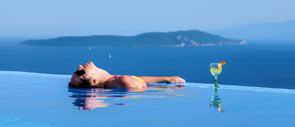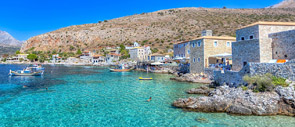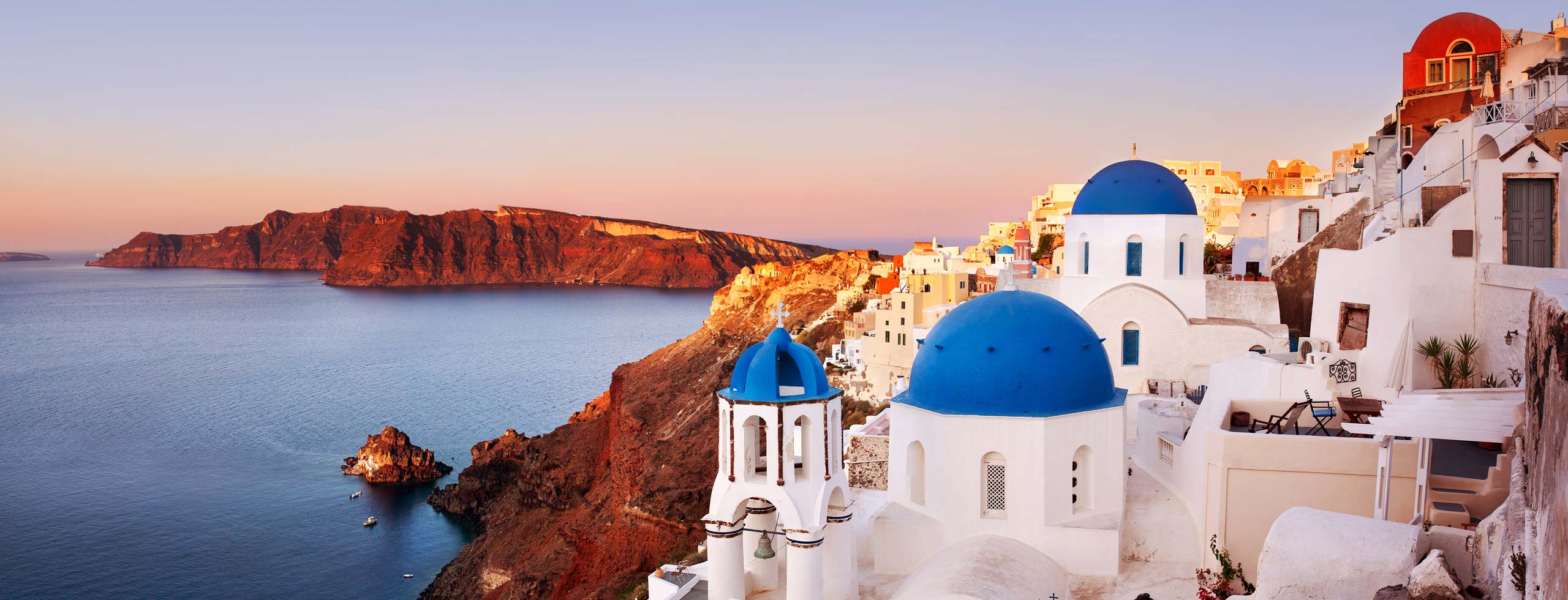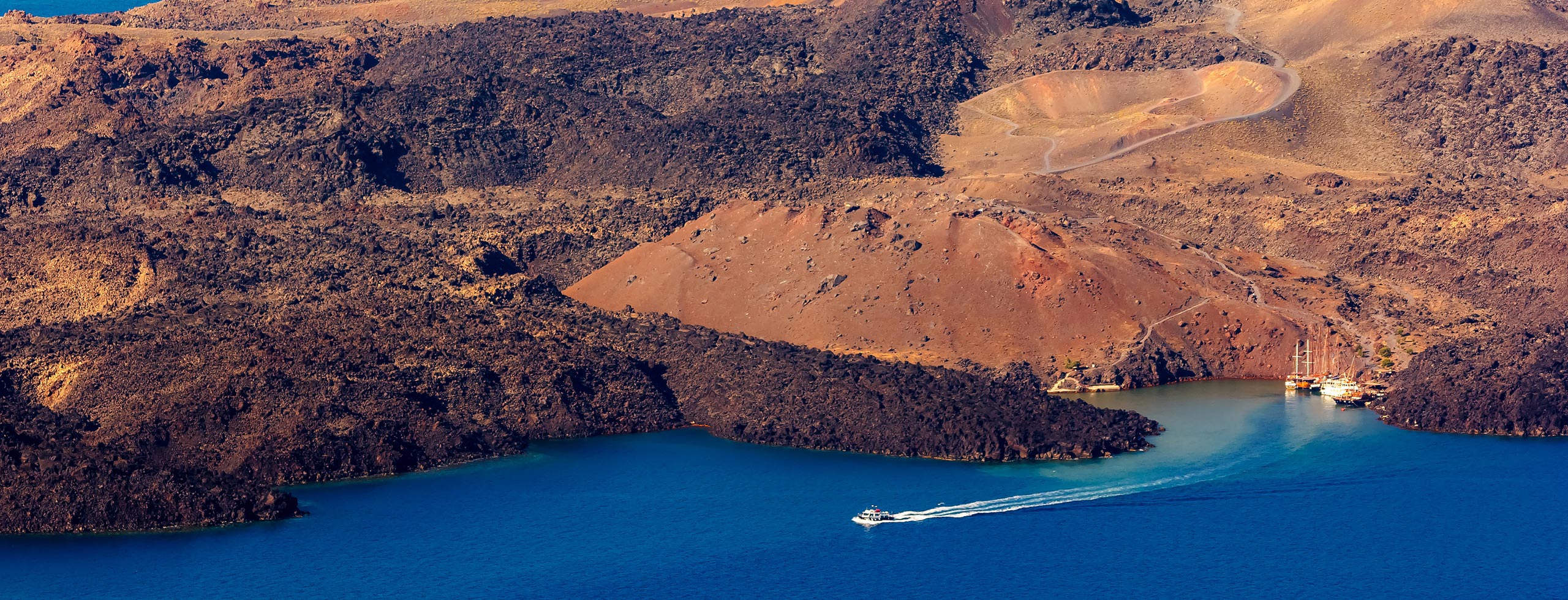Santorini Island Greece - Travel information, Santorini hotels, villas, tours, restaurants, beaches, archaeological sites, nightlife
One of the premier luxury destinations in the world, Santorini is arguably the most popular Greek island vacation spot for a romantic vacation. The Santorini Caldera, a site of fascinating beauty that developed after a volcanic explosion in the 2nd millennium BC, will certainly enchant you with its white-washed houses literally hanging from the multi-colored cliffs. The villages of Oia, Fira, Imerovigli and Pirgos provide the ideal setting for an unforgettable Greek islands vacation or Santorini honeymoon.
-->General Information
Superlatives easily come to mind when describing the Greek islands, but there can be no denying that Santorini lives up to all cast its way. Its geological features make it one of the most spectacular natural settings in the world, its tourist accommodations make it one of the most desirable vacation spots in the world, and its archaeological remains make it one of the most extraordinary historic sites in the world! It is not by chance that Santorini is perennially voted as one of the top 10 travelers’ destinations worldwide, attracting everyone from young honeymooners to older sophisticates.
Santorini Geographical Description
When approaching the island, the first thing that visitors see is what appears to be a half-moon of an island with impressive multicolored cliffs of its western inner curve rising almost a thousand feet high. This is the main island the Greeks call Thira, but is widely known as Santorini, a name that stems from an Italianate version of the island’s patron, St. Irene of Thessaloniki, who died here in 304 AD. Sitting along the edge of the high midpoint of the crescent is the main town of Fira, long the center of the tourist traffic. Perched on the northern tip of the crescent is Oia, which is now the second most popular destination for tourists, while other towns and beaches are scattered about the sloping land. A second and smaller island called Therasia is located just a bit west and across from the northern tip of the main island, while smaller islets sit in a lagoon sheltered by these two major islands.
The Caldera
This “lagoon” has a special name and history–it is a caldera! This is the name that describes a crater formed after a volcano has exploded and its cone has collapsed–in this case, a crater into which the sea rushed when the entire western edge of the volcanic island was also blown away. This is exactly what happened in the area sometime around 1450 BC, although some scholars now tend to move this event back to about 1625 BC. At the time of its eruption the volcano appears to have given warning signs so that most, if not all, of the people dwelling here got away, and then proceeded to bury their towns and settlements under layers of ash, pumice, and lava, which are evident today in the colorful layers that are highly visible on the exposed inner cliffs of the crescent. There have been other eruptions and explosions over the centuries since, one as recently as 1928, as well as a major earthquake in 1956. In fact, one of the inner islets, New or Great Kameni, remains slightly active, emitting gases and vapors that make for the dramatic sunsets that visitors now enjoy as they sit on their hotel balconies and sip their cool drinks. Surprisingly, the volcanic soil has proven to be good for growing grapes and tomatoes.
Many scientists regard the explosion on Santorini as the most powerful natural catastrophe ever to have originated on Earth (much more powerful than the explosion of Krakatoa off Java in 1889). Both its resultant tsunami, or tidal wave, and the massive fallout of ash appear to have headed mainly to the south, enabling some archaeologists to claim that these may have had an impact that led to the collapse of the Minoan civilization on the island of Crete. Within the last century a new theory has emerged that claims that it was this explosion, the destruction of the settlements, and the collapse of such a landmass into the sea that formed the basis of Plato’s story of the end of Atlantis. Most students of Plato, however, regard his story as simply a fiction to make a moral point. A reasonable middle ground might accept that Plato was in part influenced by a thousand-year-old oral tradition concerning the disaster on Santorini.
Leisure on Santorini
That about does it for cultural courses on Santorini, but there are numerous churches, both Roman Catholic and Greek Orthodox, scattered throughout the island that will repay even a casual stopover. The island is so small–barely 10 miles from one end to the other–that one could easily take in its sights in a day, including the fine Byzantine church at Episkopi and the monastery outside Pyrgos on the highest point on the island.
There is much more to Santorini than the island so often pictured in the glossy travel magazines and TV commercials. That said, most visitors come to Santorini to enjoy its restaurants, shops, beaches, nightlife, and–let’s face it–to sit and enjoy the views. Several beaches are along the eastern coast, from the Red Beach near Akrotiri, up to Perissa and Kamari, then north to Monolithos, and farther north to Koloumbos and Baxedes (it should be said that these beaches are mostly composed of volcanic sand that can get very hot in July and August). There is no end of restaurants, with most of the classier ones concentrated in Fira Town. But increasingly in recent years, excellent restaurants can be found in other towns, particularly in Oia, the town at the northern tip of the island, while Fira still has the most shops, especially jewelry stores. Nightlife can be found wherever young people gather throughout the high season, just about all over the island. But the undeniable truth is that most visitors find that the true pleasure of Santorini can be found while sitting on the terrace of a cafe or restaurant, sipping a refreshing drink and taking in the amazing sunset that creates one of the most spectacular views in the world.
Santorini Through the Centuries
Whatever the truth of Atlantis, there is no denying that the explosion put a temporary end to the human settlement of Santorini (which had begun about 3500 BC), and it would be about 900 BC before humans in any significant numbers would venture to resettle here. These were Greeks, and by the 4th century BC the island was taken over by the Athenians. After the death of Alexander the Great (323 BC), Santorini came under the control of the Ptolemies who inherited Alexander’s empire based in Egypt, and of course when Rome took over Egypt, it also inherited Santorini. During Greece’s Byzantine period (395-1200 AD), Santorini was a forgotten outpost, but when Western European Crusaders captured Constantinople in 1204, Santorini was assigned to the Italians, who managed to hold onto it until the Ottoman Turks took it over in 1537. During their long and relatively benign occupation, the Italians introduced their own Roman Catholicism, with churches and other institutions that survive to this day.
The Turks also left Santorini pretty much untouched, and when Greece won its independence in 1829, Santorini joined what would become the modern Greek nation. Individual Santorinians who prospered in shipping or other businesses enriched their island with fine mansions, but for the most part it remained in the shadow of more glamorous Greek islands.
The Tourism Explosion and the Akrotiri Excavation
Individual travelers from Western Europe would occasionally visit and write about the unusual aspects of Santorini, but it was not until the 1970s that it began to come into focus on the screen of mass tourism, and this in turn was influenced by the excavation of the great site known as Akrotiri, situated along the southwestern coast.
Although a few archaeologists had long known of some remains under the layers of volcanic fallout, major digging only began in 1967, and soon revealed an incredibly well-preserved town, complete with roads, buildings as high as three stories, frescoed rooms, countless ceramics and other artifacts. The fact that there have been no human remains and almost no valuable metal objects confirms that the inhabitants at the time were able to evacuate before the great explosion. Even those with only passing interest in archaeology and ancient history will want to give a few hours to visit this unique site, while others may choose to also visit the Museum of Prehistoric Thira in Fira, home to some of the frescoes and major finds at Akrotiri.
Ancient Thira
There is no use pretending that most people come to Santorini to track down archaeological sites, but one more should be singled out because it is so spectacular in its own way. This is Ancient Thira, located on a peak abutting the southeast coast, albeit with adventurous access demanding an uphill hike. First settled by Greeks as early as 850 BC, its major remains date from approximately 550 BC to 150 AD. Although no individual building is significant, strolling among them with the wind playing about your ears and the dramatic vistas over the sea and land below is an unforgettable experience. Remains from this site and various other sites around the island can be found in the fine Archaeological Museum in Fira.
Route 1: Explore the Capital of Fira, Firostefani, and Imerovigli
The spectacular town of Fira blends in perfectly with the deep blue sea and the small volcanic islands that form the renowned Caldera, the much photographed volcanic basin of Santorini. Walking around the narrow streets of Fira among white walls and colorful shops is something you must not miss. Under the wild cliffs that host Fira is the old harbor from where you can catch the boat to visit Nea Kameni. We highly recommend that you visit this volcano island for a chance to take a once-in-a-lifetime walk around its crater. You can go to the harbor either by the cable car (teleferique), on foot, or by a more unusual but traditional way–riding one of the island’s remaining mules or donkeys! Of course you could instead enjoy the famous sunset of the Aegean at one of the many bars or restaurants of Fira that offer a fabulous view of the caldera!
Other beautiful sunset spots can be found in the town of Imerovigli, which literally means “the day watch.” Imerovigli is an approximate 30-minute walk following the traditional old path through the outskirts of Fira and the town of Firostefani. En route to Imerovigli you will see the Catholic Cathedral and interesting Dominican monastery of Santa Ekaterina, built in 1596, and when you arrive you may spend your time exploring the Frankish past of the island. At the location called Skaros, just outside Imerovigli, you can see the ruins of a medieval settlement, the first settlement the Franks built when they came to Santorini. It was in this castle of Skaros that the Venetians raised their flag and renamed the island from its original ancient name of Thira to Santa Irene. This later became abbreviated to Santorini–just a bit more history to share with your friends back home!
Another great town, about two miles (three kilometers) south of Fira that you might like to visit is the traditional village of Vourvoulos. Here you will find great tavernas and restaurants for a Greek-style meal, and may also swim at some of the fine sandy beaches of Santorini–Vourvoulos and Xeropigado.
Route 2: Exploring the Village of Oia
The northern part of the island is dominated by one of the most famous and beautiful villages of Greece, Oia. Although Fira draws most of the island’s visitors and has the ultimate cosmopolitan atmosphere, Oia boasts the best view of the island and caldera, and is the place for more quiet moments. Sunsets here are truly magical and visitors attest that the most spectacular and breathtaking sunset can be seen from the medieval ruins of Oia, at the location called Goulas (don’t go there without enough space in your digital memory card!). Traditional Cycladic architecture is at its finest in Oia. You can spend what seems like an infinite amount of time walking among the small white houses and sparkling blue domes of the uncountable little churches, many of which are built deep in the volcanic soil–these are the famous yposcafa, literally “built underground”. Among the typical traditional houses you may also see the mariners’ mansions built in the late 19th century with strong characteristics of neoclassical architecture.
As you walk through the narrow paths, you cannot help but notice the many galleries that make Oia a very much alive cultural center not only to its visitors, but also to the many artists who live and create in this beautiful village. Under the cliff of Oia you are able to swim at the small and picturesque beaches of Ammoudi and Armeni. Other larger yet less crowded beaches can be found at the northern edge of the island close to the small traditional settlements of Tholos and Finikia. The beaches of Koloumbos, Baxedes, and Pori, covered with sand and sparkling pebbles will surely enchant you.
Route 3: Eastern Santorini
Although you will likely spend most of your time in the famous villages of Fira, Oia Imerovigli, and Firostefani, all built on the edge of the cliff, there are other just as beautiful sites and interesting villages spread over the central and eastern part of the island. Among the tomato fields, gardens and small green hills, between the towns of Messaria and Megalochori, you will find Santorini’s famous vineyards. The old Santorinian wineries are definitely worth the visit. You will have the opportunity to see old wine vaults dug into the soil, called canaves, and learn how wine producers of Santorini have been creating their tasteful products–famous in all of Greece and some even worldwide!
Approximately 2.5 miles (4 kilometers) from Fira you will find the picturesque town of Messaria. This beautiful town is home to the best wines of the island and claims the title of “Queen of the Vineyards!” In Messaria you will also see the post-Byzantine churches of Aghia Irene and Metamorphosis as well as the unique Argiros Mansion, built in 1888–all are interesting sites. From Messaria continue to the small village of Vothonas. Along the way notice the stunning small church built in a cave, but the most interesting religious monument of the area is the Byzantine church of the Virgin Mary in Episkopi Gonias, built in the 11th century by the Byzantine Emperor Alexios Komninos I. Next you may wish to visit the Kamari Beach, one of the best options for a swim on the island, featuring an impressive 1.3-mile (2-kilometer) stretch of sand. From here you can follow the curvy road that takes you up the hill and over Kamari, and then follow the path that leads to the remains of the Dorian city of Ancient Thira. As enjoyable as the site itself is, the view of the eastern coast is spectacular. If for this reason alone, Ancient Thira is definitely worth a visit.
Route 4: Southern Santorini
On the southern part of the island you will find Santorini’s most colorful beaches. At cosmopolitan Perissa, which extends to Perivolos, you can dive in the sparkling waters of this black, volcanic, and pebble-covered beach. If you want to step away from it all, you may explore the nearby church of Santa Irene. This church is especially worth visiting if you are on the island on August 29th, when there is a festival in honor of the island’s patron Saint. Near Perissa is the picturesque village of Emporio, where you can see remains of a medieval fortified castle. Another road leads you to Pyrgos, a charming village with many old churches and a Venetian castle. From Pyrgos you can travel to the peak of Profitis Elias, the highest point on the island, where the historical monastery of the same name sits. Built in 1771, it is the proud host of an interesting collection of ecclesiastical articles of priceless value.
Akrotiri is the last village in the southwestern part of the island. Adjacent to the village is where you will find one of the most impressive archaeological sites in Greece, the prehistoric town of Thira, where the excavations that began in 1967 have brought to light a semi-intact old city of the 3rd-2nd millennium BC. Walking around the streets of this prehistoric town and seeing the actual houses is a truly spectacular experience–one you will surely remember for a lifetime (please check that the Akrotiri is open to the public before your visit, since restoration work is still on-going). Near Akrotiri there are some nice and isolated beaches, such as the Red Beach, the White Beach, Mesa Pigadia, and Almira. You can reach them either by boat or on foot following a dirt road. Even if you are not the walking type, it is worth the pleasant hike to enjoy a truly wonderful aspect of Santorini’s nature and landscape.
Museums & Activities
- Akrotiri: Visit this semi-intact old city of the 3rd-2nd millennium B.C. Among the many remains that were discovered lie some fine frescoes with scenes from nature and everyday life of the time. As of April 2012, the Akrotiri Archaeological site is once again open to the public after intensive restoration work.
- Archaeological Museum, Fira: Learn more about the excavations in Ancient Thira from the wonderful exhibits displayed in the museum’s showcases.
- Gizi Mansion, Fira: Built in 1700, the Gizi Mansion is an interesting remain of the Frankish past of Fira, worth a visit to see the exhibition of charts, folk artifacts, historical manuscripts, old photos and gravures.
- Museum of Folk Art, Fira: This museum offers an interesting glimpse of the traditional island life of the 19th-century.
- Museum of Prehistoric Thira, Fira: Visit this stunning museum if you want to know more about prehistoric Thira and the ancient town that has come to light at Akrotiri during the excavations in the 20th century.
- The Naval Museum, Oia: Located in the Birbilis mansion, this Naval Museum will take you on a journey into the past to share in the memories of the times when Oia was a naval power and its mariners owned 164 vessels.








 View Santorini Map
View Santorini Map 